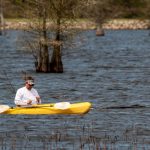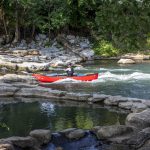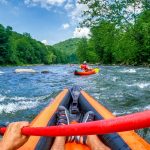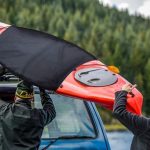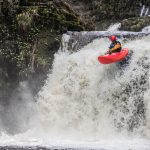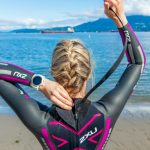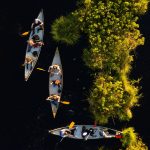To fish in fast moving rivers and streams, you need special skills and a specialized kayak. But how do you choose one? We're here to help!
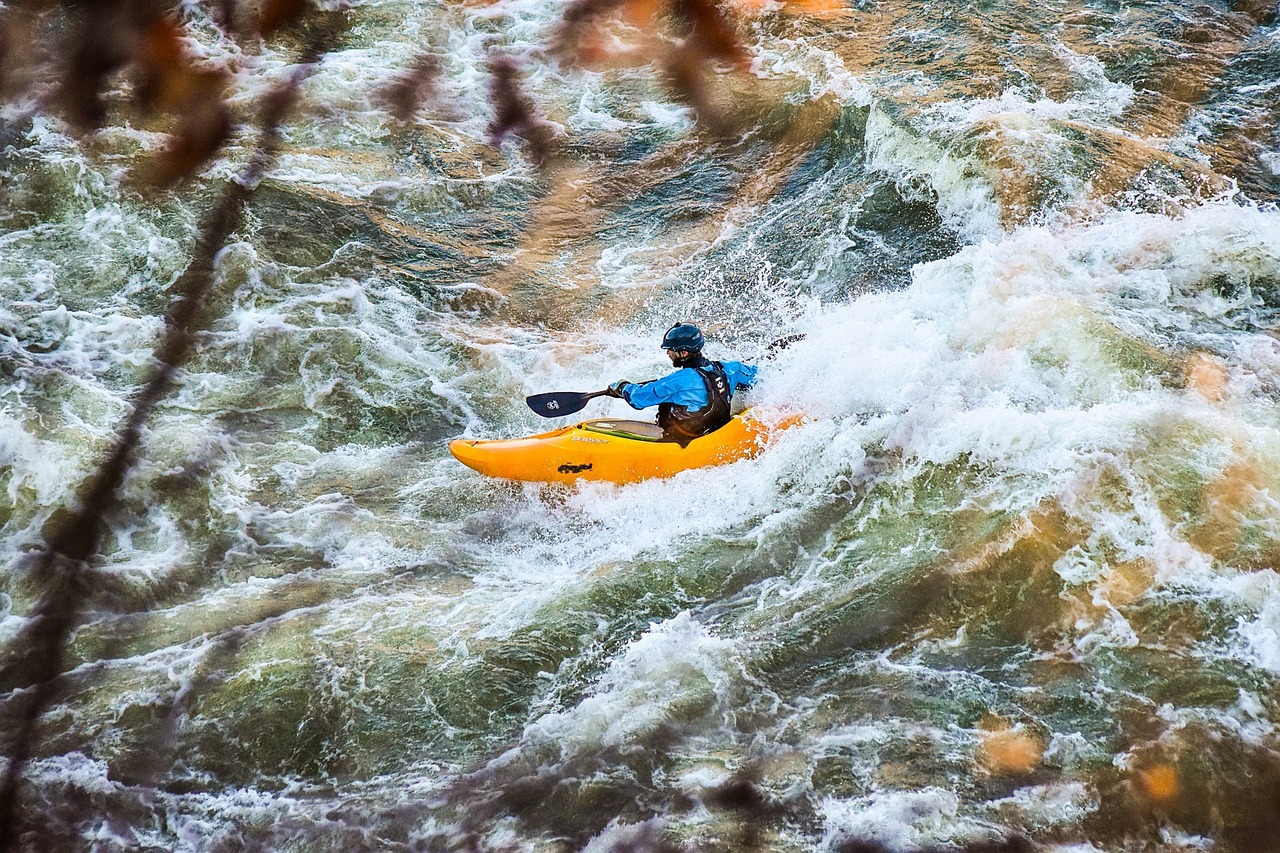
Shooting white water rapids is one of the most exhilarating things you can do in a kayak. Crashing over waves, bouncing past rocks, and blasting over waterfalls is a must for a lot of kayakers, and it’s watching videos of expert kayakers making these moves look easy that gets a lot of people into white water.
But these expert kayakers have years and kayaking under their belts, on rapids of all different classifications.
Sure, we would all love to be able to jump on a river for the first time and style some top-end rapids, but there’s a learning curve and we need to know where we’re at on it.
The different classes of rapids grade water by difficult and potential consequences of coming out of your kayak so that you can plan your trip and progress your kayaking. Understanding these rapid classifications is essential for your safety, but also so that you can enjoy your time white water kayaking.
White Water Classes: A quick rundown
Want the lowdown quickly on river classifications? Below is our short and sweet river classes. Alternatively, check out this video from white water legend Eric Jackson explaining river grading:
Class I: Easy flowing river, small ripples.
Class II: Waves and white water, but no technical moves
Class III: A clear line down the rapid, but you have to make a move, good boat control is needed.
Class IV: Harder to spot the line, technical features throughout the rapids, and some difficult moves. There are consequences to a swim.
Class V: Extreme rapids with a high level of technicality and/or consequence. Challenging moves and unclear lines, for experts only.
Class VI: Rarely run, extreme in every sense, and rescue is difficult or impossible. Most class VI rapids are downgraded to V if they become a regular run.
What are the Classes of Rapids

Rivers rapids are classified from I – VI, with higher numbers meaning harder rapids. This scale is not fixed and is also not perfectly linear, so it can be difficult to accurately grade a rapid. There are general rules that put rapids into particular classifications, but they are not exact.
Classifications of rapids are worked out on two principles; technical difficulty, and consequence. For example, there can be difficult class II rapids that have absolutely no consequence, while some class III might feel easier but have a higher consequence if you were to capsize or swim from your kayak.
In a guidebook, or online, the river will be given an overall grading. This classification reflects the general makeup of the river, but there will always be more detail given to it. If a river is predominantly one class but has one or two notable rapids of a higher class that can be easily portaged, it will usually be expressed as the lower class, but with a higher class in brackets. For example, if a river was all class II, but there was a class V drop in the middle, it would be given a II(V) classification.
Who Decides the Grading?
When the rapids are first paddled, or a guidebook is written, then the paddler or guidebook will give the rapid classification based on their opinion and the current river levels. Rapid classes may change over time, with water levels, changes in features, or just general consensus. You should still use your judgment on the day to decide whether or not to paddle a rapid or a whole river.
Why Do Classifications Matter?
River classifications are there to help you pick an appropriate river for you. It’s a quick and easy way to tell whether you should or shouldn’t be considering the river, a little like the grading runs on a ski hill or a bike trail. And just like those, just because a river is graded at a certain level doesn’t automatically mean you can go and run it blindly.
A grade III river might be very different from any other grade III rivers you have paddled before, and factors like gradient, how continuous the rapids are, the river levels, and how you’re feeling on the day will all play into whether or not a river is appropriate to you. River classifications are also there to help paddlers understand what is happening under the water, or forming the rapids. Learning how to read rivers and rapids is an essential skill, first from the bank before you run a rapid, and then in a ‘read-and-run’ context, mid-flow.

Classes of Rapids and How To Read the River
Class I
Class I rapids may not even look like rapids at all but can be sections of rivers with a flow that goes beyond just cruising speed. This could be ripples or small waves, but will generally not form what you would think of as white water. Class I rapids can be enjoyed by anyone, in almost any style of kayak, without risk.
The technicality and consequence in Class I are very low. You can usually paddle any line you like down these rapids, and if you do capsize, you can safely swim your way down the rapid with limited risk.
Class II
Class II water is one of the broadest classifications. These rapids can look low and nondescript, but can also range all the way to large wave trains. With class II, you get clean chutes and channels, and these rapids are considered to be ‘point and shoot’ style runs. This means that you have time to line yourself up at the top and ride the rapid down to the bottom pool without having to change your line in the middle.
Class II rapids are considered by many to be the most fun, because they are safe and generally stress-free, requiring low technical ability. Swimming through a Class II rapid is easy and safe, but unlike class I, you will probably have to float to the end of the rapid before you swim to shore.
Class III
Class III rapids require a degree of kayak control and unlike classes I and II, you can no longer allow the water to dictate where you are going. In class III rapids, there will be a clear line choice, but there is usually an obstacle – a rock, a tree, a wave – that calls for you to change your course mid-rapid. Because of this, class III is the first grade that is not appropriate for beginner kayakers.
You can usually line up a class III rapid from the top and begin your move early, avoiding the obstacle, but you are still required to have full control of your kayak. The consequences in class III are usually low. A swim might be uncomfortable and you may bump off rocks, or get washed about a little, but you will usually come out unscathed.
When starting to paddle class III, many kayakers will inspect rapids before running them and may choose to have a safety kayak, or a safety person with a throw bag, set up for rescue.
Class III+
Class III+ bridges the gap between class III and class IV. Class III+ water will have the technical difficulty of class III, but is often more constant, requiring you to link multiple moves together in succession to negotiate a rapid. There will still be a clear line down class III+.
For example, a single shoot with a rock at the bottom would be class III but multiply this to a five-hundred-yard rapid, and you’re in class III+ territory. In class III+, you have to stay alert and zig-zag your way down the river, choosing when to power your kayak and when to turn to get the right course. Kayakers often ‘eddy hop’ down class III+, using pools of still water behind obstacles to break up their journey into smaller sections.
Class IV
Class IV is advanced white water and requires a high level of technical understanding and ability. The line through a class IV rapid is not obvious, with multiple hazards and moves at all times, but the water is predictable and there is always a way to run the rapid. Class IV rapids usually have a ‘must-make’ move that requires precise handing and technical ability.
Class IV rapids often have large waves coming from different angles, as well as features like holes – recirculating water – and rocks that represent a pin hazard. You must be in full control of your kayak in class IV, as the consequences of a swim can be dangerous. A dependable roll – to bring yourself back upright – is seen as a must-have for class IV paddlers.
Class V
Class V rapids are considered extreme, both in terms of technical demand and consequence. These rapids are often large volume with turbulent water or include drops or waterfalls that have unavoidable features – like holes – that must be negotiated. The ‘must-make’ moves on Class V rapids have dangerous consequences and require full focus and near-perfect kayak control to navigate.
Scouting these rapids is often difficult, as the eddies may be small and hard to reach. Safety may be difficult to set up and rescue is a challenge even for experienced kayakers. Class V rapids should not be taken lightly. Even class V rapids that look straightforward may have hidden currents, surprisingly sticky holes, or a move that is harder to make than it appears at first sight. Extensive experience and an in-depth understanding of rivers are required to kayak Class V rapids.
Class VI
Until recently, class VI was a grading given to rapids that were considered unrunnable. Even now, class VI is only run by expert kayakers, at certain water levels, and after considerable inspection. Rescue in class VI rapids is almost impossible, and the consequences are high.
Class VI water is unpredictable and highly turbulent, with extremely challenging moves giving you a narrow window of success. Such is the level of class VI that if a rapid is run on multiple occasions, it is often downgraded to a class V instead.
Progressing Through the Classes
As you progress in your white water kayaking skills and your understanding, you may choose to progress through the classes – or push your grade. As you push into new and harder rapids, you will find your skills are tested and you require a greater level of focus. It is recommended that pushing is a gradual process, and you only step up for a short time before returning to water you are comfortable in. Over time, you will become comfortable in a more challenging environment and you will consider your grade to have improved.
Just because you have raised your grade does not mean you should run rapids at that level without inspection or caution. Not all rapids are created equally, and a grading is only as good as the day it was graded on and the person who graded it. Even the best kayakers choose to walk rapids when they’re not feeling it, and factors like water levels, fallen trees, rock movement, and your paddling on that day can all affect whether you should, or shouldn’t, paddle a particular rapid.

